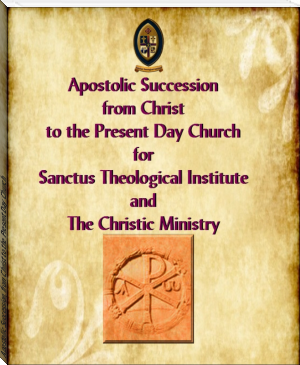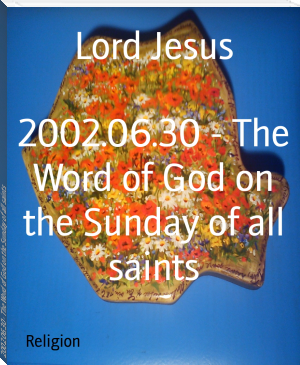Principles of Teaching by Adam S. Bennion (feel good novels .TXT) 📖

- Author: Adam S. Bennion
- Performer: -
Book online «Principles of Teaching by Adam S. Bennion (feel good novels .TXT) 📖». Author Adam S. Bennion
A similar story is told of a farmer who experienced great difficulty in keeping a particular hen inside the run which he had built outside the hen house. He had put up a wire fence high enough, as he thought, to keep in the most ambitious chicken. In fact, he argued that no hen could fly over it. One hen persisted in getting out regularly, though the farmer could never discover how she did it. Finally he decided to lay for her (she laid for him regularly). To his great surprise, he watched her walk around the run carefully surveying it as she proceeded. At length she caught sight of a beam running along the top of the wire just above the gate. With her eye fixed upon it she made one mighty effort and was over.
The moral of the two stories is self-evident. Both hens and men can "go over" if they have something to aim at. It is so in life generally, and what is true of life generally is particularly true in the matter of teaching. The aim is one of the most significant features in the teaching process.
The teacher who knows where he is going can always get followers.
Important as is the aim in all educational endeavor, it is doubly so in religious training. We teach religiously not merely to build up facts or make for mental power; we teach to mold character. We should see through facts, therefore, to the fundamental truth lying behind and beyond them. Such a truth constitutes an aim in religious instruction.
One of the most regrettable facts connected with some of our teaching is that teachers leave the preparation of their lessons until the few minutes just preceding their recitation hour. They then hurry through a mass of facts, rush into class and mull over these dry husks, unable in the rush even to see the kernel of truth lying within. Little wonder pupils tire of such rations. It is the teacher's obligation to "see through" and discover the gems that really make lessons worth while.
Forty-five minutes once a week is so meagre an allotment of time for the teaching of the greatest principles of life! Surely every one of those minutes should be sacredly guarded for the consideration of vital truths. The aim, coupled with careful organization, is one of the best safeguards possible.
The aim is the great focus for a lesson's thought. It is the center about which all else revolves. It specifies what shall be included and what excluded out of the great mass of available material. A single chapter of scripture may contain truths enough for a dozen lessons, only one of which can be treated in any one recitation. The aim singles out what can be appropriately grouped under one unified discussion.
If we turn, for instance, to the ninth chapter of Matthew, we find at least eight different major incidents, each one deserving a lesson in itself. There is the case of:
The palsy. The charge of blasphemy. The glorifying of God by the multitude. The calling of Matthew. The statement that only the sick need the physician. The case of new cloth and the old garment. The raising of the daughter of Jairus. The healing of the two blind men.It is perfectly clear that all of these incidents could not be adequately considered in any one lesson. Assuming that the teacher is free to handle this ninth chapter as he pleases, we are forced to the conclusion that knowing his class, as he does, he must choose that incident or that combination of incidents which will mean most in the lives of his pupils. In other words, he centers his attention upon one major central truth—his aim. By so doing he guards against wandering and inadequacy of treatment and makes for the unified presentation of one forceful thought.
It ought to be pointed out here that every teacher must be the judge as to what constitutes for him the best aim. It is quite clear that any one teacher could find in this ninth chapter of Matthew at least four or five worthy aims. Three different teachers could possibly find as many more, each equally worthy of development. All other things being equal, that aim is best which most completely and forcefully covers the chapter or passage in question. To illustrate: Suppose we are asked to teach a lesson on the Prodigal Son. One aim that could be chosen clearly is that of jealousy on the part of the prodigal's brother. A second one might be repentance, as typified in the action of the prodigal. Still a third might be the compassion and forgiveness of the father, as typical of those same qualities in our heavenly Father. Which, to you, is the most forceful and significant? That one to you is your best aim.
The wording of the aim is a matter that gives rise to a good bit of disagreement. There are those who maintain that if the aim announces the subject as a sort of heading that is sufficient. Others contend that the aim should crystallize into axiomatic form the thought of the lesson. Of course, the real force of the aim lies in its serving as the focus of thought. The wording of it is of secondary importance. And yet it is very excellent practice to reduce to formal statement the truth to be presented. It is helpful to adopt the ruling that the aim should express both a cause and a result. Perhaps an illustration would indicate the difference between the aim stated as a mere heading, and stated fully and formally. Take the case of the daughter of Jairus already referred to,
Mere Headings: Daughter of Jairus restored, or The power of faith. Formal Aim: Implicit faith in God wins His choicest blessings.Surely the latter is a more significant expression and offers better training to the teacher than the setting down of mere headings.
The ability thus to crystallize out of a great variety of facts a single focusing statement, coupled with the ability then to build about that statement a clearly organized amplification, is the sign of a real teacher. Instead of generalizing further, let us turn to the questions on this lesson where some laboratory exercises are set down calling for actual practice in the selection and justification of a number of aims.
Questions and Suggestions—Chapter XVII
1. What is an aim?
2. Why is it particularly essential to good religious teaching?
3. What are the objections to "eleventh-hour" preparation?
4. To what extent is a teacher handicapped in deciding upon an aim for another teacher to follow?
5. Turn to the following references and determine what possible aims might be developed under each. Is any aim adequate for the whole reference? In each case which do you consider your best aim? Why? How much of the reference would you include in a single lesson?
John, Chapter I; Isaiah, Chapter II; III Nephi, Chapter X; Doctrine & Covenants, Section 87.
Helpful References
Colgrove, The Teacher and the School; Betts, How to Teach Religion; Driggs, The Art of Teaching; Strayer and Norsworthy, How to Teach.
CHAPTER XVIII APPLICATIONOutline—Chapter XVIII
The question of application.—The matter a complex one.—Various conceptions of the term as it affects the intellect, the emotions, or the will.—Application may be immediate or delayed.—How to make the application.—Illustrations.—Making the application and moralizing.—Utah moral codes as objectives behind our teaching.
Application is one of the most important subjects in the whole range of religious education. It is also one concerning which there are greater varieties of opinions than concerning almost any other subject.
What is application?
How is it made?
Is it inherent in the lesson, or is it added as a sort of supplement to the lesson?
When is it best made?
Does it always involve action?
These questions are only typical of the uncertainty that exists relative to this term.
Application really goes to the very heart of all teaching. Colloquially expressed, it raises the question in teaching, "What's the use?" Why should certain subject matter be presented to a class? How are class members better for having considered particular facts? In short, application involves the question, "What is the carry-over value of the lesson?"
It is impossible to dispose adequately of the matter of application in a single statement. It fairly epitomizes the whole process of teaching and therefore is so comprehensive that it calls for analysis. The ultimate purpose behind teaching, of course, as behind all life, is salvation. But salvation is not had in a day. It is not the result of a single act, nor does it grow out of particular thoughts and aspirations. Salvation is achieved as a sum total of all that we think, say, do, and are. Any lesson, therefore, that makes pupils better in thought, word, deed, or being, has had to that extent its application.
Application of a lesson involves, then, the making sure, on the part of the teacher, that the truths taught carry over into the life of the pupil and modify it for good. Someone has said that the application has been made when a pupil
"Knows more, Feels better, Acts more nobly,"as a result of the teaching done. There is a prevalent conception that application has been made in a recitation only when pupils go out from a recitation and translate the principle studied into immediate action. There are lessons where such applications can be made and, of course, they are to be commended. Particularly are they valuable in the case of young children. But surely there are other justifiable interpretations to the term application.
We need to remind ourselves that there are three distinct types of subject matter that constitute the body of our teaching material. These are, first of all, those lessons which are almost wholly intellectual. Debates are conducted by the hundreds on subjects that lead not to action but to clearer judgment. Classes study subjects by the month for the purpose of satisfying intellectual hunger. Such questions, for instance, as "Succession in the Presidency," or the "Nature of the Godhead"—questions gone into by thoroughly converted Latter-day Saints, not to bring themselves into the Church, nor to lead themselves into any other kind of action except the satisfying of their own souls as to the truth. In other words, it appears clear that there may be application on a purely intellectual level. Application upon application is made until a person builds up a structure of faith that stands upon the rock in the face of all difficulties.
A second type of lessons appeals to the emotions. They aim to make pupils feel better. They may or may not lead to immediate action. Ideally, of course, every worthy emotion aroused should find, if possible, suitable channels for expression. Pent up emotions may become positively harmful. The younger the pupils the more especially is this true. Practically every educator recognizes this fact and gives expression to it in language similar to the following quotation from Professor S.H. Clark:
"Never awaken an emotion unless, at the same





Comments (0)